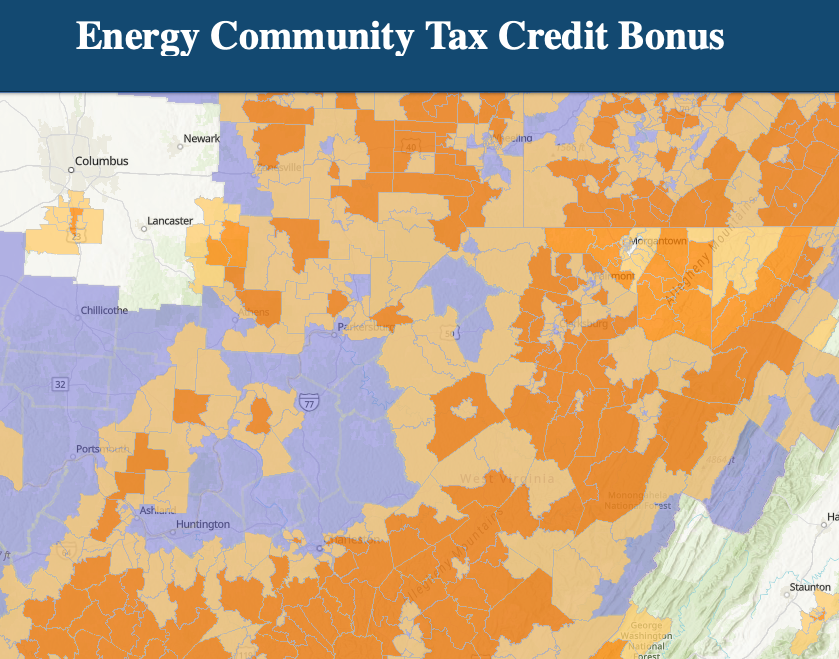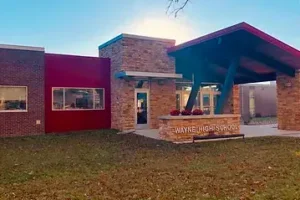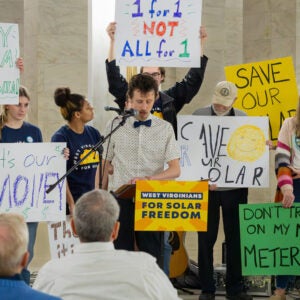 When congress passed the Inflation Reduction Act back in August 2022, we celebrated BIG TIME— what a massive win for solar! Since then, we’ve been anxiously awaiting additional guidance and mapping from the US Treasury so we can confidently identify which businesses and nonprofits in our region qualify for which benefits.
When congress passed the Inflation Reduction Act back in August 2022, we celebrated BIG TIME— what a massive win for solar! Since then, we’ve been anxiously awaiting additional guidance and mapping from the US Treasury so we can confidently identify which businesses and nonprofits in our region qualify for which benefits.
In case you’ve forgotten, the IRA includes a baseline 30% tax credit that any organization can take advantage of. Plus, there are additional credits that can be layered on top of that. One is a 10% Energy Communities credit that was handmade for Appalachia and finally, after months of anticipation, we have the official map!
The big takeaway is that this is great for most of our region. In West Virginia, nearly every county (52 out of 55, to be precise) can take advantage of the Energy Community tax credit, meaning most nonprofits and businesses in the state will see their tax credit jump from 30% to 40%. (As a Shepherdstown born company, our deepest sympathies to the three Eastern Panhandle Counties that don’t qualify.)
The other big news to keep in mind is that some areas are locked in as Energy Communities for the lifetime of the incentive, currently slated to last until 2032. But other areas risk falling off the map because they’ll be reevaluated each year. For those folks, the time to go solar is RIGHT NOW.
How does it work?
The law identifies key factors to define and designate “Energy Communities.” If your business or nonprofit is located in a region that meets the following criteria, you’re eligible:
- The community experienced a coal mine closure anytime this century.
- The community is adjacent to a community that experienced a coal mine closure this century
-OR-
- The community experienced a coal-fired plant closure anytime since January 1, 2010.
- The community is adjacent to a community that experienced a coal-fired plant closure anytime since January 1, 2010.
Y’all are safe. I mean, we’d love to see you go solar tomorrow, but the truth is you’ll have access to that 10% energy community credit for the next decade.
The other organizations that qualify are located in regions that don’t meet the above requirements, but do meet certain unemployment statistics. These are the areas that could fall off the map and lose the Energy Community credit in years to come. Each year as new unemployment data comes in, the maps will change, so if you’re in one of those regions best to act now! Here’s the technical criteria:
- At least 0.17% of the community’s population is employed in the extraction, processing, transportation or storage of coal, oil or natural gas.
- At least 25% of local tax revenues are related to the extraction, processing, transportation or storage of coal, oil or natural gas.
-AND-
- The community’s unemployment rate is at or above the national average based on employment data for the previous year.
Sounds a little complicated, right?
Don’t worry – you don’t have to be a research statistician to determine whether your organization is in an Energy Community – we have maps!

Link to Map: Energy Communities
Energy Communities are shown in gold, orange and purple – and we sure do have a lot of gold, orange and purple in our neck of the woods!
Gold and orange = 10% tax credit for the next decade.
Purple = 10% tax credit for this year. (This designation is based on annual employment data and is subject to change each year.)
Is your organization in an Energy Community?
Go solar before the maps change again next year.





